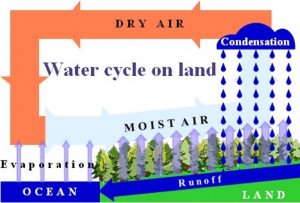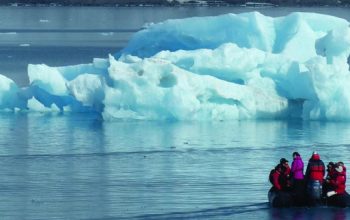Prof. Alexander A. Startsev, Grand PhD,
Professor of the International University of Fundamental Education, Oxford Educational Network,
Member – Correspondent of the Russian Academy of Nature Science
Director of the International Centre for the Promotion of UNIDO Programs and Projects Implementation at Peter the Great Saint-Petersburg Polytechnic University,
UNIDO International Expert
The UN posits that “climate change is primarily a water crisis” and that “water and climate change are inextricably linked”. At the same time, the impacts of climate change are widely recognized as a serious threat to international peace and security.
In the end of 2020 the UN Special Commission reported that if the situation with a climate change continues to develop in the same way, by the year 2050 about 200 – 300 million people will start migrating from their traditional habitats. This phenomenon has no analogues in the human history. What shall we do? No one knows. All concepts regarding borders of countries lose their meaning. The UN Special Commission states that the humanity has no efficient approaches to control over these processes.
The world scientific achievements and latest technologies amaze the imagination with fantastic prospects of the future world. However, the main blind spot in modern science remains the question of how do ecosystems such as natural forests, swamps, rivers, lakes, tundra and oceans that not yet disturbed by man function? Where does all fresh water come from? How life in these ecosystems was not interrupted and the environment remained livable for hundreds of millions of years? Without answering these questions vitally essential for civilization, it is impossible to speak definitely about our future.
Over half a century of intensive scientific research, global satellite and ground-based observing systems have been created and data on the state of the environment that are unprecedented in volume and detail have been obtained. The analysis of these data revealed the complexity and insufficiency of research on interconnection of biogeophysical processes that determine the Earth’s climate. However, a large uncertainty relates to atmospheric moisture. On the one hand, water vapor and clouds greatly contribute to the greenhouse effect (like carbon dioxide, they redirect heat radiation back to the Earth surface that results in its heating). On the other hand, clouds reflect solar radiation back into space and cool the Earth surface. Without a reliable assessment of the role of atmospheric moisture, it is impossible to assess the effect of excess carbon dioxide on the climate. Therefore, during the last two decades the world meteorological community has been focusing on the water phase transitions such as evaporation and condensation. [1].
For centuries, the civilization has been destroying the natural vegetation cover, particularly including forests. The most rapid deforestation began in the 20th century, particularly due to massive forest cuttings and fires. This process has accelerated the onset of the global water crisis. In the climate agenda, deforestation was initially viewed only as an additional source of carbon dioxide emissions (or its depositing in the case of reforestation), altering the reflectivity of the planet. However, the accumulated data on the key role of forests in the regulation of atmospheric moisture indicate a possible underestimation of deforestation and replacement of pristine forests with artificial plantations derivatives as factors of climate destabilization and fresh water shortage.

Natural intact uneven-aged dark coniferous forests with a stable flow of tree generations (left) and a post-fire even-aged pine forest (right).
Long-term observations have shown that on land, evaporation is almost completely determined by the vegetation cover, mainly by natural forests. These revelations promoted the further intensive research in this area. [2].
For the last quarter of a century, the renowned researchers Dr. Gorshkov V.G. and Dr. Makarieva A.M. (Saint-Petersburg, Russia) formulated and proved two globally significant discoveries, including: 1) Concept of biotic regulation of the environment and climate, with quantitative assessment of stabilizing effect of natural ecosystems on the environment, climate change and the state of water resources; 2) Theory of the biotic pump of atmospheric moisture, providing a quantitative evaluation of pristine forests in transportation of atmospheric moisture from the ocean and atmospheric condensation on land. In respect of the global water crisis, we will consider the second discovery in more detail. Numerous studies by Russian scientists have shown that condensation of water vapor is the main driving force behind the Earth’s atmospheric circulation. [3].
However, the biotic pump theory goes against the traditional paradigm claiming that the kinetic energy of the wind is generated not by water condensation but by the temperature gradient. Many textbooks on meteorology still provide a diagram of the water cycle in nature indicating the ocean evaporation as the main cause of atmospheric moisture condensation in clouds precipitation as rains. This traditional scheme completely ignores the role of vegetation and especially natural forests acting like giant fountains and generating winds.
Biotic forest pump mechanism
The sun energy generates an intensive evaporation (transpiration) from pristine forests, about an order of magnitude exceeding the evaporation from the same area above the ocean. The transpiration maintains dense condensation of water vapor over land. Further, water vapor condenses and passes from the gas phase into clouds filled with water droplets, leading to a rarefaction of air in the atmosphere above the forest. These low pressure areas promote ascending air currents over the forest and “pumping” of high-humid air from the ocean, which rains down and snows in winter in northern latitudes. Most (about 2/3) of the precipitated fresh water maintains the balance of water in rivers and wetlands, feeds lakes and providing the vital activity of flora and fauna, and also evaporates again over land. The rest of the precipitation in the normal cycle flows down the rivers back into the ocean. All moisture on land drains into the ocean in 4 years. This mechanism, explains why rain does not fall over the desert. There is no moisture in the desert and there is nothing to evaporate. Therefore, such areas feature with permanently higher pressure compared to the ocean, where evaporation and condensation of moisture only take place in this case. So, the wind in the desert always blows from land to sea, but never in the opposite direction!
This simple yet far-reaching physical theory describes how the water vapor exhaled by trees creates winds. Thus, the Russian natural boreal forest, stretching over 7 thousand kilometers from Northern Europe to the Far East, is an essential component of the global biotic forest pump. It supplies fresh water to Western Europe, Russia, Central Asia, Mongolia and China. Thanks to these boreal forests, winds from the Atlantic cross the continent, carrying humid air across Europe and through Siberia to Mongolia and China. These winds carry the rains that feed the lakes and rivers of Eurasia, including the giant rivers of Eastern Siberia.

Biotic regulation of the water cycle on land. Only natural ecosystems undisturbed by human activities are able to perform fully the regulatory functions [4]
The same winds bring moisture to China’s northern plain, the granary of the most populous country on the planet. China receives 80% of its fresh water from the west – and this is mainly Atlantic moisture, which is “pumped in” by the natural taiga forests of Eurasia. Moreover, the path of atmospheric moisture transfer occurs in several stages involving transpiration cycles with associated rain and takes six months or more. This phenomenon contradicts the traditional notions taught at school. Paradoxically, China is close to the Pacific Ocean, but most of its rainfall is moisture from land in the far west. [5].
A natural forest is an integrated system of trees of different ages and other biological species, including bacteria, fungi, insects, birds, small and large animals, all of them participating in the forest life processes. All this complex activity of the natural forest community for millions of years is aimed mainly at maintaining the stability of the fresh water cycle, without which life is impossible. When a coniferous forests are partially destroyed by natural disasters(hurricanes, lightning strikes, etc.), natural restoration processes (succession or self-healing) last over a hundred of years. [6].
Purposeful deforestation and burning of forests, negligent fires, destruction of native forests lead to a serious disruption of soil water evaporation. If the areas of destroyed forests are significant, erosion of low atmospheric pressure zones occurs. This results in abnormally hot springs and rainy, cold summers. The mechanism of biotic forest pump for transporting atmospheric moisture from the coastal sea zones to inland becomes poorly regulated (the bioticpump “sneezes”). These factors also lead to the increase of abnormal weather phenomena, such as either droughts accompanied by fires, or disastrous floods, when large masses of moisture abruptly flow onto land and flood settlements, agricultural land and other territories, resulting in the excess of fresh water that is impossible to use and causing catastrophic situations when flora and fauna die and people have to save themselves.
Anthropogenic destruction of natural forests results in the degradation of all their biodiversity and their ecological succession proceeds extremely slow taking many tens of years due to destruction of all the biodiversity of the natural forest. Deciduous trees after the tree clearings and fires do not form soon. They cannot draw moisture from the ocean in the spring months before foliage forms and, accordingly, provide a sufficiently high degree of evaporation. The result is a drought in the interior of the continent and catastrophic floods in the coastal regions, where all moisture that has not penetrated inland will accumulate.
A complete destruction of pristine forests blocks the considered biotic pump and turns any river basin to the desert over about several decades. In the last century, dramatic consequences resulting from a sharp shortage of precipitation led to the disappearance of the Aral Sea. The basin of the formerly rich Amu Darya and Syr Darya rivers feeding the sea disastrously shallowed. [7].
What is the value of natural forests? In 1986 – 1997, an experiment called “Biosphere-2” was carried out in the United States in the state of Arizona. It was the most ambitious biophysical project ever undertaken by the scientific community, costing US$ 200 million at the time (much more than US$ 1 billion at current prices – A.S.). In 1991, eight scientists entered a sealed and glazed research facility with the floor area of the 1.3 hectare,where they were to remain isolated from the outside world for two years. Inside the dome, diverse ecosystems, including rainforest, swamp, agricultural field, savannah, desert and ocean with coral reef were created. In this nature-simulating environment the “biospherians” were accompanied by insects, bees and butterflies, fish, reptiles and mammals, which were thoroughly selected to support the vital functions of the ecosystem that was supposed to provide the circulation of air, water and nutrients in order to (a) to maintain the atmosphere composition acceptable to humans; b) provide the sources of food for the participating humans.
After 17 months, the experiment had to be stopped ahead of schedule. Due to the drop in oxygen levels under the dome, where people were already breathing thin air, as at 5300 m above the sea level. The first and main lesson: natural components, as in a natural ecosystem, cannot be created by humans for any money. Lesson two: there is a real possibility of sudden, dramatic changes in ecosystems. The natural environment is a nonlinear system, which tends to maintain dynamic equilibrium under the influence of disturbances, but only up to a certain threshold. Then, even small shifts in equilibrium can cause abrupt changes that transfer the system to a nonequilibrium state with rapid fluctuations that means passing the point of no return. [8].
The accelerated artificial reforestation that simulates natural forests restoration turned out to be inefficient. Artificial forest plantations do not recover and maintain the natural water cycle. Furthermore, numerous examples, particularly including the failure of planting of greenery in China started 25 years ago, show that they are unstable and undergo a rapid degradation from drought or pests. All these facts confirm the vital necessity in the preservation of pristine forests still existing on the planet.
In view of the growing global shortage of drinking water, taking into account the key role of natural forests in a sustainable freshwater cycle and in order to effectively manage water resources, the following measures are suggested for consideration and implementation at both international and national levels:
- to identify and legally establish in national forest registers a new category of forests, i.e. climatic and water regulatory forests (pristine or weakly disturbed forest areas that perform a continental regulatory function for the atmospheric moisture transportation from the ocean and precipitation stability on land);
- development of a new concept of woodworking industry, taking into account the fundamental difference between climatic and water-regulatory forests, which are exclusively subject to protection and monitoring, and commercial forests (for industrial and consumption purposes);
- climatic and water regulation forests should be completely protected from any industrial and commercial activities, including forest concessions and currently popular ecotourism; in fact, these forests should become a specially protected restricted area, free of even small aircraft flights (probably except drones with environmentally friendly engines for monitoring purposes);
- creation of commercial forests (forest plantations) with artificial and combined reforestation to provide the maximum economic return from intensive forestry based on modern scientific developments in accelerated tree growing and “circular economy” principles involving deep processing, implementation of the most advanced technologies (waste-free processes, developments of modern biochemistry) contributing to the intensification of consumer forestry;
- include a new priority for scientific research “Forest and Water: Physical and biological foundations of the environment and life sustainability” in national and international programs. This research direction should be based on the interdisciplinary approach, involving the integrated participation of specialists from different fields of science (currently working in their own narrow areas without the consideration of complex worldwide situation and problems).
- development of the educational course “Natural science foundations of forest and water resources sustainability in the biosphere” and its implementation in all universities, as well as performing advanced training courses and workshops for state officials, industrial and business communities to disseminate knowledgeabout the “technosphere-biosphere” system as a part of the competence in all levels of management;
- in the field of social policy: 1) consider the protection and preservation of natural forests as a priority in international cooperation; 2) provide the conditions for the involvement of the expert and civil society in addressing the problems of natural forests protection and preservation, monitoring and controlling their condition, exchange of experience between regions and countries; 3) ensure the availability of the comparative monitoring data for the worldwide community;
- in the field of nature-like technologies: 1) development of technologies for wood/timber replacement by other materials, particularly in paper and packaging industries, 2) introduction of blockchain technologies to control timber turnover and exclude illegal forestry exploitation; 3) use the potential of information and communication technologies, digitalization, aerospace surveillance equipment for continuous monitoring and forecasting of the state of natural forests using artificial intelligence algorithms; 4) address climate change problems with the assessment of the stabilizing potential of biota and natural forests at the level sufficient for ecosystems to maintain the environment and water balance suitable for life;
- in the international dimension, seek recognition of Russia and its mission as an environmental donor and guarantor of climate sustainability in Eurasia and worldwide. Russia is a scientific leader in the field of fundamental research on environmental sustainability, including the invention of biotic regulation concept for the environment and climate (1995), as well as the global level discovery of a forest biotic pump of atmospheric moisture (2005);
- extension and intensification of the international cooperation in the field of protection of the Eurasian boreal forest belt, since the biotic pump is free of state borders and provides fresh water for all Eurasian countries, including Russia;
- organization of “International interdisciplinary research center for boreal forests sustainability”, based on the scientific research results of St. Petersburg scientists V.G. Gorshkov and A.M. Makarieva;
- exploring the potential of the Geneva Water Center, UN structures and other international associations for cooperation among the countries preserving large areas of pristine forests and including Russia, Brazil, countries of the Congo River Basin, Indonesia, Papua New Guinea, Canada. This cooperation should include measures towards the elimination of natural forests exploitation and development of commercial forest plantations around the world.
References:
[1] Schiermeier Q. (2010) The real holes in climate science. Nature 463: 284-287.
[2] Jasechko S., Sharp Z.D., Gibson J.J., Birks S.J., Yi Y., Fawcett P.J. (2013) Terrestrial water fluxes dominated by transpiration. Nature 496: 347-350.
[3] Gorshkov V.G., Makarieva A.M. (2002-2020) https://www.bioticregulation.ru/pubs/pubs2_r.php
[4] Makarieva A.M., Gorshkov V.G. (2012) Preservation of the Eurasian forest belt as Russia’s strategic goal. Energy: Economics, Technology, Ecology, 9(2012), 18-25 (in Russian). URL: https://www.bioticregulation.ru/ab.php?id=eete12
[5] Pearce F. (2020) https://www.sciencemag.org/news/2020/06/controversial-russian-theory-claims-forests-don-t-just-make-rain-they-make-wind, DOI: 10.1126/science.368.6497.1302.
[6] Gorshkov V.G., Makarieva A.M. (2007) Biotic pump of atmospheric moisture as driver of the hydrological cycle on land. Hydrology and Earth System Sciences 11, 1013-1033.
[7] Startsev A.A. (2016) Paris International Agreement on Climate Control: Concerning Scientific Validity of Selected Priority in Countering Global Warming. Russian Economic Journal. No. 6 (2016), 25-31 [in Russian].
[8] Startsev A.A. (2012) The Unique Nature of Russia is the Hope and Salvation of Civilization. www.ippj.ru History. Low. Policy. No. 2 (2012), 77-82 [in Russian].



